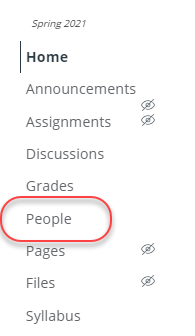Managing Your Course Roster
The "People" tab shows all the users enrolled in your course, either added by you or added automa tically through the Banner system.
tically through the Banner system.
- Primary instructors and registered students are auto-populated into their courses using the Banner system.
- Secondary instructors, TAs, and any other role would need to be manually enrolled by the primary instructor of the course.
You can also view the number of current users in a course from the Course Settings page.